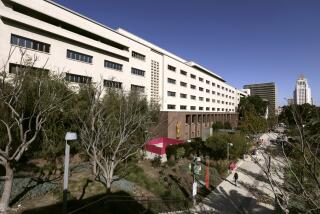Creator of ‘Phonehenge West’ to testify in code enforcement case
- Share via
Lawyers for an Acton property owner accused of building code violations will seek to defend his elaborate home expansion project as a work of art in a trial in Lancaster slated to wrap up this week.
Alan Kimble Fahey, 59, spent almost three decades constructing the 20,000-square-foot labyrinth of interconnected buildings — including a 70-foot tower — he calls Phonehenge West. In 2008, Los Angeles County code enforcement officials ordered him to stop. They have demanded that he tear the structure down.
Prosecutors subsequently charged him with 14 criminal misdemeanor counts that include maintenance of un-permitted properties and unlawful use of land, and a jury began hearing testimony last week in the unusual case. Fahey could spend up to seven years in prison if found guilty.
Fahey’s lawyer, Jerry Lennon, said that his client’s creation was unique and that regulators should demonstrate some flexibility.
“There should be room in the world of administrative regulations where they account for people like Fahey,” Lennon said. “He’s not hurting anyone; and I don’t think there’s a mechanical or structural problem he can’t resolve.”
Lennon also argued that building code officials were lax in tracking the case over many years and missed opportunities to find an equitable solution.
But in opening arguments last week, Los Angeles County deputy Dist. Atty. Patrick David Campbell told jurors that Fahey flouted building code regulations because he considered himself above the law and that he set his own standards for construction.
“Fahey doesn’t believe the rules apply to him,” Campbell said. “He has set up his own arrogant interpretation of the law.”
Speaking before Superior Court Judge Daviann L. Mitchell, Campbell said the foundations of several of Fahey’s structures were built with telephone poles and were “inherently unsafe” and could hurt people. He summed up the case as “Never-Never Land.”
The prosecutor called on building code and zoning enforcement officials, who detailed the process for applying for building permits and the history of the agency’s dealings with Fahey.
Daniel Geringer, a county regional planning assistant, told the court that Fahey had been notified that he was in violation on several fronts. The infractions included maintaining a structure that exceeds the maximum height limit of 35 feet and possession of two noncommercial wind turbines.
Francis Dominguez, office manager for the county Department of Public Works, Building and Safety, said Fahey was asked to submit plans for his project but told officials that he couldn’t because “he didn’t know how it was going to turn out.”
Fahey’s case has triggered an outpouring of support from fans who share his defiance of code enforcement. His creation is composed of a hodgepodge of reddish buildings braced with scores of utility poles and steel beams and connected by bridges and ramps. One of the buildings is a barn, where Fahey lives with his wife and 16-year-old son. Another is a trailer painted to look like a rail car. The 70-foot tower is adorned with Italian stained-glass windows.
A collector of curios and more than 20,000 books, Fahey said he planned to create a museum, library and gift shop that would make money for his family and the community of Acton. He also wants to build a crafts workshop for disabled children.
Dominguez recounted numerous occasions when inspectors from his agency visited Fahey between 1986 and 1995 and again in 2006 and 2007. Citations and a stop-work order were issued, but Fahey refused to cease, Dominguez said.
But Lennon, Fahey’s attorney, said code enforcers were at fault for dropping the ball on his client’s case for several years. Fahey has said they backed off for two decades.
“They should be accountable for some of their negligence,” Lennon said.
In his opening statements, Lennon told jurors that Fahey was a “clever craftsman” with “a strong imagination.” He argued that his client had been “candid and open” in his dealings with county bureaucrats, and he called regulators’ approach to the problem in recent years Kafkaesque.
Fahey requested suggestions from building code inspectors, Lennon said, but “there was never a meaningful discussion about how they were going to solve this problem.”
Lennon said he planned to call Fahey as his key witness this week.
“He’s got a lot at stake,” the attorney said. “He’s got a lot of sweat equity in that building.”
More to Read
Sign up for Essential California
The most important California stories and recommendations in your inbox every morning.
You may occasionally receive promotional content from the Los Angeles Times.













